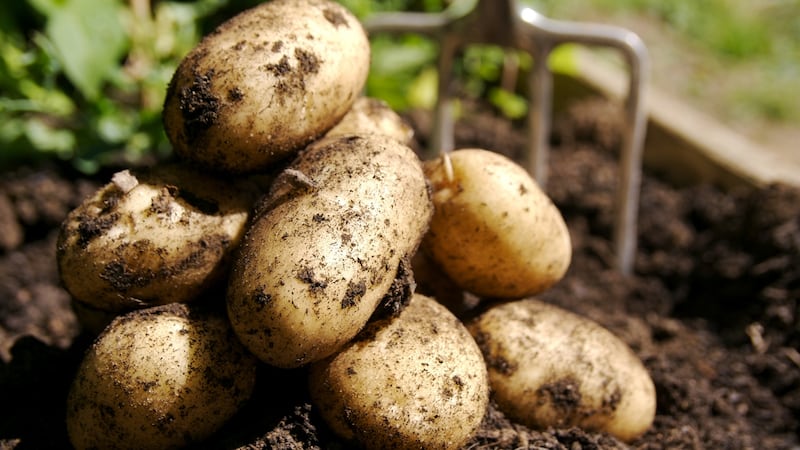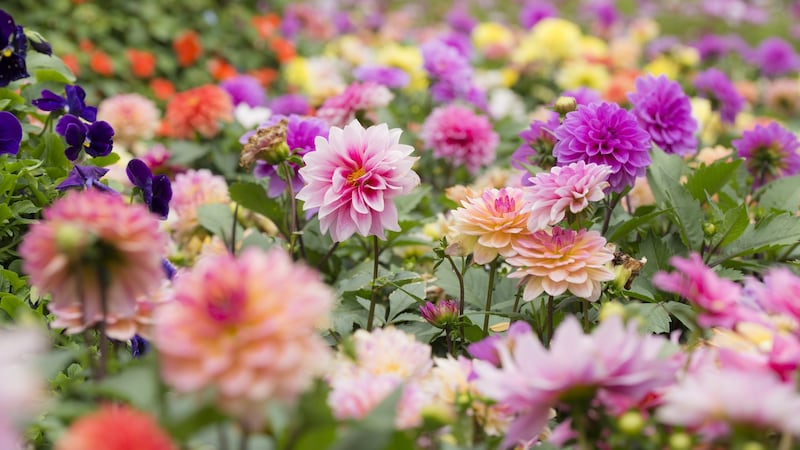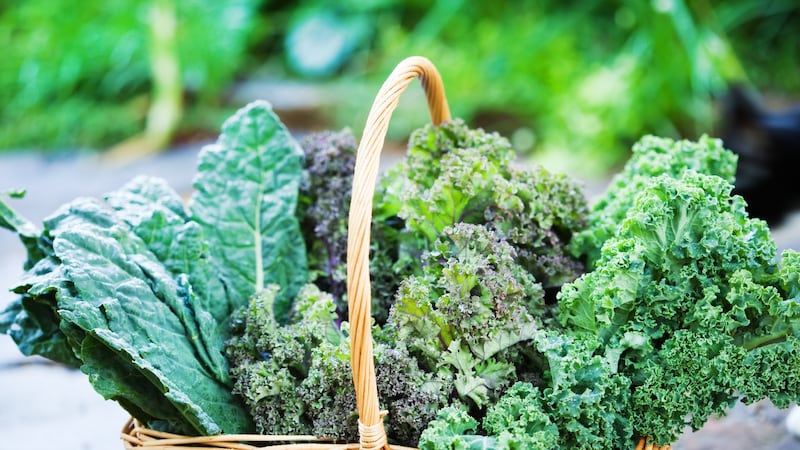Some homegrown vegetables are delightful to eat, yet frustratingly short-lived. But others are the gifts that keep on giving throughout the long, dark, cold months of winter and early spring, either because they store brilliantly, or because they are impressively resilient to the rigours of our Irish climate. As the 2022 growing season kicks in and the threat of food insecurity looms once more, here’s a useful short list of five of the latter to grow in your garden or allotment this year.
Jerusalem artichoke
Yes, it’s true, this nutty-flavoured tuberous vegetable has earned itself the moniker of ‘fartichoke’ for a very good reason, but it’s also delicious, nutritious and wonderfully suitable for growing in an Irish garden or allotment as long as it’s given the space it needs. An impressively productive and easy-to-cultivate plant that’s delicious roasted, fried, boiled, baked, stir-fried, used in cakes, fritters, souffles, rostis or soups, or even simply grated raw into a salad. Jerusalem artichoke will happily grow in sun or light shade and in most soils (the only exceptions are those that are very wet or very acidic), quickly reaching a lofty height of 2.5m to 3m. Cold winter temperatures also improve the flavour of the tubers, which deteriorate quickly in quality once they’re lifted, meaning you only need to harvest them as required.
March-April is the perfect time to plant the tubers, which should be planted 10-15cm deep, 30-50cm apart, and into a sheltered spot in the garden or allotment where the plant's tall stems won't be snapped by strong winds. Protect the emerging shoots from slugs, 'earth' the young shoots up in early summer by drawing fresh soil up around them with a hoe, and pinch out the young flower buds as they develop in summer to encourage the plants to pour all their energy into tuber production. Recommended stockists include Green Vegetable Seeds (greenvegetableseeds.com), Quickcrop (quickcrop.ie) and most good garden centres.
Winter squash
Delicious roasted, added to a curry, risotto or stew, or used as a key ingredient in a nourishing winter soup, these fleshy, flavoursome, supremely long-lasting, savoury fruits will last in storage for many months so long as you “cure” them by leaving them to sit in a bright, dry, sunny spot for a couple of weeks immediately after harvesting.
High-yielding and reliable, the varieties known as ‘Uchiki Kuri’, ‘Tiptop’, ‘Autumn Crown’ and ‘Crown Prince’ are among the best for our cool, damp Irish climate. Unsuitable for small spaces, these heat-loving plants need plenty of room to romp, a very sheltered position in full sun and a deep, very fertile, moisture-retentive but free-draining soil. A tender annual, winter squash won’t tolerate any degree of frost, so sow the seed on its side under cover and with generous heat (21-24 degrees) into individual pots from the beginning of April (for growing on in a polytunnel) to the end of April (for an outdoor crop). Then transplant the hardened-off young plants out into their final growing position after all the risk of frost has passed. Keep them well watered and make sure to take careful precautions against slugs.

Potatoes
Who doesn't love the taste of homegrown potatoes? But if you want spuds suitable for storing for use throughout the winter and spring months, then you'll need to choose what's known as a maincrop variety. Perhaps the best-known example is 'Golden Wonder' (available from Dublin-based mrmiddleton.com), the very firm, golden-fleshed variety whose flavour and texture continues to improve over the time the tubers spend in storage. Other lesser-known, but great maincrop varieties, include 'Carolus', 'Alouette', 'Vitabella' and 'Twister', all of which have good disease-resistance and are available to buy as organic seed tubers from Cork-based suppliers Fruithill Farm.
Maincrop varieties of potatoes are also much slower to mature than earlies, typically requiring anywhere from 18-22 weeks until ready to harvest. Suitable for planting from mid to late April, chitting/pre-sprouting the seed tubers indoors in a bright, frost-free place for a few weeks before planting will help to start them into early growth. Give them a deep, weed-free, rich, free-draining but moisture-retentive soil, in full sun or light shade, and work some well-rotted manure or garden compost and a few handfuls of organic slow-release fertiliser into the soil close to planting time.
Always gently handle chitted seed potatoes to avoid damaging the emerging shoots, planting them so that the individual tubers are spaced 30-40cm apart, with 60-75cm between rows, and making sure to cover them with soil to a minimum depth of 25-30cm. Protect the emerging growth from late frosts by covering on cold nights with a layer of fleece. Maincrop potatoes are typically harvested in October, after which they should be stored in a cool, dry, dark, frost-free, rodent-free place such as a garden shed or disused chest freezer.

Dahlias
Yes, that’s correct, this showy star of the flower garden is also a delicious food crop whose plump, fleshy tubers can be roasted, fried or baked in much the same ways that its not-so-distant relative the potato can be.
In fact, long before European gardeners started growing them for their colourful, beautiful blooms, the Aztecs cultivated these plants, which they called ‘acocoxochitle’, for their sweet, starchy, edible tubers. Those same tubers can also be used to make ice-cream, dahlia crisps, dahlia chips or even as a key ingredient in cakes. Or you can use them chopped and shredded in a salad (lightly steam them first) or in soups. As for the flavour, it varies considerably according to the individual variety but typically ranges from nutty to fruity.
A tender, tuberous perennial, dahlias should be planted as plump, healthy tubers into three-litre pots under cover of a frost-free polytunnel, porch or glasshouse at this time of year for transplanting outdoors in early summer into a sunny, sheltered spot and a rich, deep, free-draining but moisture-retentive soil in full sun. It’s also important to protect the emerging shoots from slugs and snails and to stake the plants from strong winds. Then sit back and enjoy those gloriously beautiful, edible blooms from mid-summer until the first harsh frosts, after which you can either lift the tubers and store them in a frost-free shed or mulch them with a layer of bracken/dead leaves until you want to harvest them. Just don’t forget to keep a few viable tubers aside for planting out next year.

Kale
Packed full of nutrients, resilient in the face of our cool, wet winters, very easy to grow, tolerant of a wide range of growing conditions and impressively prolific, this delicious and hugely versatile leafy vegetable was a mainstay of the Irish diet for centuries. Treated as a cut-and-come-again crop, it will give a prolonged harvest over many months from early winter until late spring, making it a kitchen garden essential. Of the vast and baffling range of kale species and varieties suitable for growing in an Irish garden (many of which also make fine ornamental plants), some of my favourites include Ragged Jack, ‘Redbor’ and the Italian kale known as ‘Nero di Toscana’.
Recommended stockists of kale seed include Cork-based Brown Envelope Seeds (brownenvelopeseeds.com) and Sligo-based Green Vegetable Seeds (greenvegetableseeds.com) while you can also buy young module-raised transplants in good garden centres in spring-early summer. For best results, sow the tiny seed from April-late June under cover into modules for transplanting out into the garden a month later, ideally into a fertile, free-draining, neutral to alkaline soil. Like all brassicas, kale needs to be protected with fine netting/enviromesh or horticultural fleece from common pests such as cabbage white butterfly and pigeons.
This Week in the Garden:
Keep any young seedlings raised under cover of a polytunnel or glasshouse sufficiently watered and protect them from icy nights with either a few layers of horticultural fleece suspended above the trays/pots, or a thermostatically-controlled glasshouse heater. Take precautions against slugs also, which can easily devastate trays of young seedlings overnight.
This is a good time of the year to weed around the base of climbers, shrubs, roses, fruit bushes and fruit trees, then sprinkle a handful of slow-release organic fertiliser followed by a light organic mulch of well-rotted manure or garden compost, making sure that the latter doesn’t come into direct contact with plant stems.
Dates For Your Diary . . . Abundant Vegetable Growing
Sunday, March 27th, (10am-4pm), Killruddery House & Gardens, Bray, County Wicklow
A one-day hands-on workshop with the master organic grower and kitchen gardener Dermot Carey, on how to plan and propagate your own nature-friendly vegetable patch. €150, see killruddery.com













